Welcome to another Sunday edition of Charlottesville Community Engagement, an irregularly produced newsletter that is usually podcast as well. This particular installment of the podcast is slightly longer than what you’ll read in the written version to make up some production changes this week. This is due to a recent break in the space time continuum. Or at least, a readjustment of gravity.
Town Crier Productions is nearly in its fourth year of existence and continues to plot the way to expansion at a time when there seems to be a lot to know. I’m Sean Tubbs, looking for my astrolabe.
Sign up for a free email if you’re new. There’s an app, too! Consider paying if you want to find out what happens.
In today’s edition:
The Democratic primary for City Council and area General Assembly races is in two days and the latest campaign finance reports are in
Charlottesville City Council learns how the city’s transit agency is hiring a third party firm for a microtransit pilot in Albemarle County
The University of Virginia is about to have a new person running parking and transportation, and Charlottesville gets a bike and pedestrian coordinator
A deep look at what’s in the University of Virginia’s next master plan document
First shout-out: Piedmont Master Gardeners celebrates Pollinator Week
In today’s first subscriber-supported shout-out, it is Pollinator Week and the Piedmont Master Gardeners want you to join them at the Center at Belvedere on Tuesday, June 20 at 5:30 p.m. for a tour and open house of their rose and pollinator demonstration gardens. An hour later at 6 p.m. there will be a presentation on “How to Create a Pollinator Paradise in Your Yard.”
The pollinator demonstration garden comprises mostly native perennials and grasses and is designed to provide food, shelter and nesting areas for pollinators throughout the growing season. The garden earned certification as a Monarch Waystation by Monarchwatch.org and succeeded in attracting monarch butterflies and nurturing them through their lifecycle in its first year.
Callsen leads fundraising in House District 54 race
There’s only two days left until party primaries in Virginia and candidates have submitted their campaign finance reports through June 8, 2023. We all owe a great deal of gratitude to the Virginia Public Access Project for making them easy to read.
In the open seat for the new House District 54, Albemarle School Board Chair Katrina Callsen leads the three-way pack with $172,976 raised to date in the whole campaign. That includes $61,987 in donations from April 1 to June 8. That includes a new $20,000 contribution from Sonjia Smith of Albemarle County, $14,250 from Leadership for Educational Equity, and $5,000 from the Virginia Trial Lawyers Association.
Smith has a total of $60,000 on the Callsen campaign to date, more than a third of her total contributions.
Callsen has spent $142,879 so far in the race including $65,447 on radio and television advertisements. Another $35,150 was spent on mailers.
Former City Councilor Dave Norris has raised $35,636 in the campaign to date, including $6,025 in the current period. So far, the former manager of the Charlottesville Parking Center has spent $20,800 including $4,296 in online advertisements and $1,409 on ads on the Charlottesville Radio Group.
Bellamy Brown, a 2021 candidate for City Council and former member of the formerly-named Police Civilian Review Board, has raised a total of $18,326 in the race so far including a $5,000 loan. His campaign has spent $12,859 to date including $7,500 in mailers.
Laufer exceeds Squire in House District 55 campaign finance race
In the open seat for the new House District 55, former Charlottesville School Board member Amy Laufer has raised more money than emergency room nurse Kellen Squire as of June 8, 2023.
Laufer has raised $317,169 in the race so far, including $100,948 in the period between April 1 and June 8. That includes $20,000 from Emily’s List and $12,000 from developer Barbara Fried.
The Laufer campaign spent $148,580 in the period and $218,774 in the overall race. That includes $72,959 on mailers and $40,730 on advertising on television and radio.
Squire has raised $212,187 in his campaign to date including $43,542 in in-kind contributions. There were $61,738 in contributions in the latest reporting period. His campaign has spent $197,385 so far in the race including $63,805 on mailers, $23,935 on television and radio, and $17,970 on online advertising.
There is a Republican in the race according to the Virginia Public Access Project. Reid Werning, did not raise any money in the reporting period. Engage Louisa reports that he is an aerospace engineer.
Delegate Rob Bell opted to not run for re-election, as reported in the March 1 edition of this newsletter.
A pitch for the podcast, Information Charlottesville
If you listen to the podcast, this is where two stories from previous editions of this newsletter are captured in audio. If you’ve not heard the podcast before, I now explain that I will continue to both doing both, but I may not be able to do so all of the time.
My writing style depends on listening to audio, and I do all of this because I wanted to be a radio producer. In a normal week, it is no trouble to produce both at the same time.
It’s not been a normal week.
The following two stories from previous installments are in the podcast. These are links to their posting on Information Charlottesville. That is a website I set up to serve as an archive for stories that appear first in this newsletter. You can look back through several years worth of coverage.
But for now, here are links to the two stories:
Stroman to become Charlottesville City Attorney, June 13, 2023
City Council poised to authorize funding for CRHA to purchase Fry’s Spring property, June 14, 2023
There are other stories in those two editions of the newsletter, but I’m not going to voice those up. If you would like to hear them, feel free to do so yourself, preferably with a beat behind it.
Council briefed on Albemarle microtransit program
Charlottesville Area Transit is continuing to plan for a one-year pilot to run microtransit operations in two sections of Albemarle County.
Last August, the Virginia Department of Rail and Public Transportation awarded a $1.552 million grant to CAT to provide the service. Firms had until April 26 to respond to a request for proposals to operate the service for CAT.
“We’re fairly close I believe, within the next month or so, to being able to hopefully come back to Albemarle County with a recommendation from our group that’s been looking at this,” said CAT Manager Garland Williams at Council’s meeting on June 6.
The service will be branded as CAT.
“What you see on the street will look like CAT,” Sanders said.
“It’s not going to be you’re calling up a third-party group and you’ll get a different name,” Williams said. “You’ll call CAT. It will look like CAT.”
At least one member of the Board of Supervisors expressed concerns in February that CAT may not be up for the job.
UVA getting new parking and transportation director
Becca White will retire from the position of director of Parking and Transportation after serving for many years.
“She leaves behind quite a legacy for our system of parking, transportation, transportation demand management, regional transportation collaboration, and just the enthusiasm that she would bring to everything that she did which will be hard to replace,” said Bill Palmer, UVA’s non-voting representative on the Charlottesville Planning Commission.
UVA last updated its Transportation Demand Management Plan in July 2019. (view the plan)
The job of implementing the plan will now be up to Scott Silsdorf, the person hired to replace White. Silsdorf has most recently been the director of transportation and parking services at Old Dominion University.
“He had been managing their parking and transportation program for the last 20 years,” Palmer said.
In other personnel news, the City of Charlottesville has finally hired a bike and pedestrian coordinator after the position remained vacant for two and a half years. Tommy Safranek, a former manager at the National Park Service, started work this week. His work on building trails was profiled by the Daily Progress last year as part of the Distinguished Dozen series. (read the story)
“If you’re playing along at home, that means we’ve fully staffed up our transportation planning team,” said James Freas, the city’s director of neighborhood development services.
The hiring of Safranek follows the hiring of Ben Chambers as transportation planning manager. Charlottesville is still working to complete design work for several streetscape projects that have not yet gone to construction. Chambers briefed Council in March on efforts to get things moving.
Pun intended.
Second shout-out: Plant Northern Piedmont Natives
Since the beginning of this newsletter, one Patreon supporter has dedicated their shout-out to an organization that seeks to draw awareness of the importance of native species to the ecosystem. As we approach summer, Plant Northern Piedmont Natives wants you to know they’ve printed over 9,280 copies of their guide Piedmont Native Plants: A Guide for Landscapes and Gardens.
In this guide, Piedmont native plants are defined as plants that evolved before the influences of European settlements began to shape and change the landscape. Plants included in the guide were selected from the Digital Atlas of the Virginia Flora and occur naturally within the region.
You can download your copy today for free!
Grounds Framework Plan points way to future of UVA’s built environment
There are ways to understand what the region’s largest employers plan for their future, and this is a major topic area for Charlottesville Community Engagement. Here are some stories from recent years:
UVA Board of Visitors panel briefed on data science center, Brandon Avenue dorm, June 6, 2019
UVA Panel endorses hotel and conference center design, March 6, 2021
UVA making plans for Ivy Gardens redevelopment, June 9, 2021
UVA continues to develop next master plan, July 13, 2022
UVA Buildings and Grounds Committee reviews new buildings at Fontaine Research Center, March 3, 2023
UVA building report on Fontaine, Center for Politics: Does Area B still exist?, March 18, 2023
Proposed UVA Capital Plan includes $7 million for second-year housing initiative, April 6, 2023
There’s almost a billion dollars of construction projects underway at the University of Virginia on land that is exempt both from local control and taxation authority. Each project came out of a series of plans. What’s being planned for the future, and how can anyone in the public find out?
In addition to the watching the Building and Grounds Committee of the UVA Board of Visitors, the public can inspect materials available on the website of the UVA Office of the Architect.
One very important document is the draft of The Grounds Plan: A Framework for Campus Planning dated March 2023. The executive summary refers to the plan by its more common name.
“The Grounds Framework Plan is a comprehensive guide intended for the overall development of the University of Virginia’s (UVA) Grounds over the next 10–20 years,” reads that summary.
The plan calls for flexible redevelopment to support a variety of UVA-wide initiatives in support of a strategic plan called the 2030 Great and Good Plan. One overarching theme is regional cooperation. (read September 2022 story)
“Acknowledge the importance of being a good neighbor and a strong partner to the greater Charlottesville region,” reads a bullet point.
There are several planning principles listed to guide the plan’s development to follow that goal.
“Support development of a comprehensive, integrated regional transit system that better serves staff, faculty, students, and visitors.”
“Collaborate with the City, County, regional agencies, and community groups to address mutually beneficial issues.”
“Use land and infrastructure on Grounds efficiently for compact growth, collaboration, and protection of natural areas.”
“Conserve significant natural features on Grounds while maintaining public access to trails.”
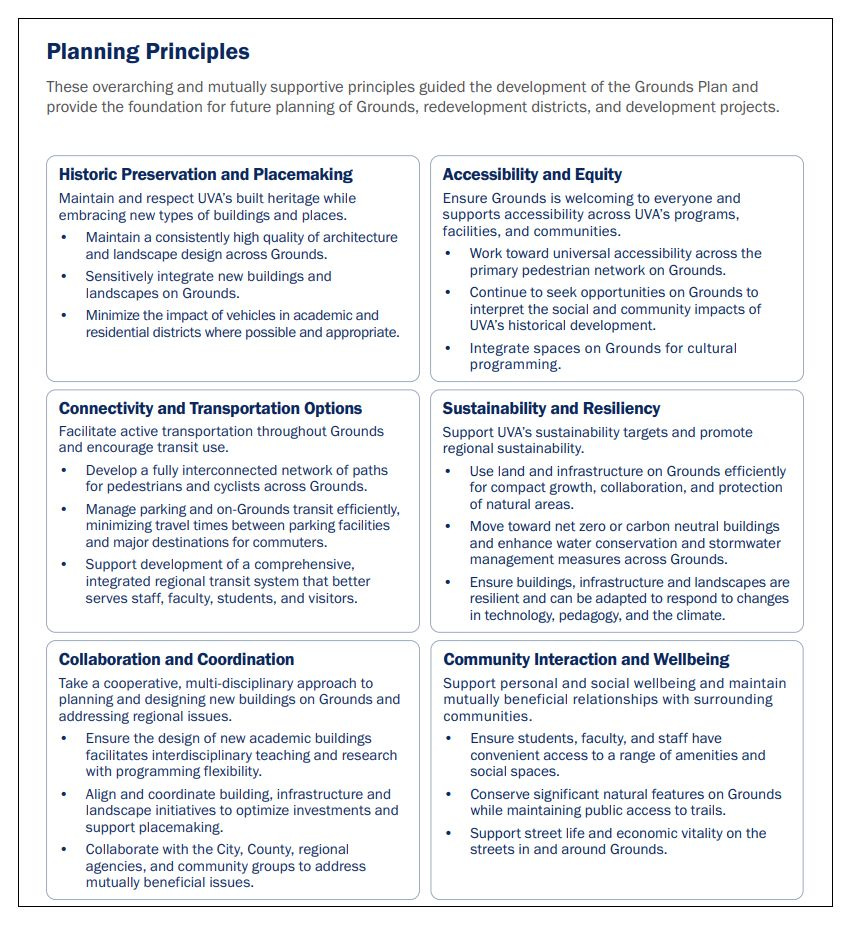
The main idea in the plan is to direct growth into three redevelopment zones
“The Academic-Mixed Use and Residential-Mixed Use Redevelopment Zones allow for higher density development with integrated green space and infrastructure that supports placemaking and improves connectivity on Grounds,” reads page 5 of the plan. “Occupying approximately 230 acres in total, they have capacity to accommodate UVA’s projected facility growth in the next 20+ years.”
One zone would seek to extend Central Grounds towards the Emmet Ivy Corridor. The student neighborhoods in North Grounds would get “varied uses and amenities over time.” West Grounds would seek to implement “opportunities to intensify existing academic, research, and student housing facilities.”
One thing to note on the map is that the property on Grove Street at Roosevelt Brown south of the railroad tracks is shown as Residential Mixed-Use Redevelopment Zone.
“The university paid $8.73 million in late August [2016] to acquire a total of 2.63 acres on seven properties on Grove Street and King Street,” I wrote in September 2016 for Charlottesville Tomorrow.
This purchase was unusual because UVA purchased it directly rather than have the UVA Foundation make the acquisition. That entity’s creation was called for in 1986 Three Party Agreement between Albemarle, Charlottesville, and UVA. (view the agreement)
Stacey Hall on West Main Street is within an Academic Mixed-Use Redevelopment Zone, though a matrix on page 40 of the plan indicates that residential would be okay as a primary use.
Directing the next set of master plans
The last Grounds Plan was adopted in 2008 and introduced the concept of Redevelopment Zones that directed the creation of master plans for the Brandon Avenue corridor, the Emmet-Ivy Corridor, and redevelopment of sites on the northern side of Ivy Mountain.
When adopted, the draft framework plan will direct new areas for the next generation of master plans.
The plan refers several times to the impact UVA activities have on local governments.
“Connections for pedestrians and cyclists between Central Grounds, North Grounds and Fontaine Park, are reliant on the City and County road network,” reads page 13 of the plan. “The combination of a varied topography, busy streets, a rail corridor, and athletics fields make this a difficult challenge to overcome. The opportunity addressed by the Grounds Plan is to continue to build more direct, lighted pathways separated from busy roads across Grounds.”
The new framework also states UVA’s objective to provide enough housing for all second-year students.
“This may increase the demand for more amenities on Grounds,” the plan continues.
The framework also restates UVA’s commitment to the Affordable Housing Initiative.
“This initiative is supporting the development of 1,000- 1,500 affordable housing units over a decade in Charlottesville and Albemarle County on parcels owned by the University and the UVA Foundation,” reads page 14.
According to the website of the President’s Council on UVA-Community Partnerships, two of the three announced areas are still in the request for proposal stage. In February, five entities were asked to submit their proposals for the Piedmont site on Fontaine Avenue and the Wertland Street site.
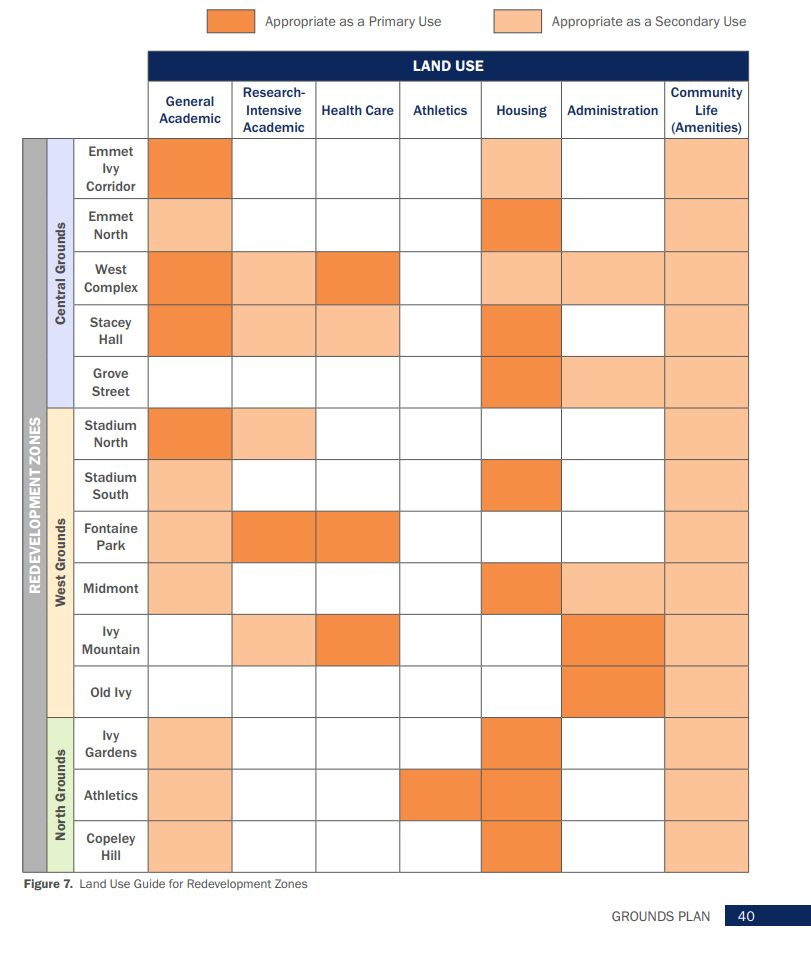
Closed-door group discusses the Grounds Framework Plan
This draft is from March. Have you heard about it? Has the closed-door group known as the Land Use Environmental and Planning Committee (LUEPC) discussed it?
The group has met once since April, but their website has not been updated. Thankfully the city’s representative provided an update from the missing meeting at the Planning Commission meeting on June 16.
“The discussions were regarding the water supply plan, and also what’s going on with the UVA Grounds and the Framework plan and any progress being made,” said Commissioner Hosea Mitchell.
Mitchell said he had sent the presentations for both discussions to his fellow Planning Commissioners. I’ll work on getting those, but will note that this one sentence prompted a deep dive into what’s in the Grounds Framework Plan.
That’s all the information in part because Mitchell’s comments at previous meetings have drawn the concern of officials who would prefer that what happens at LUEPC stays at LUEPC.
There will be a change to the charter of LUEPC, according to the minutes of the April meeting.
“Jodie [Filardo] will develop a sample statement for initial consideration by the Planning Team regarding the confidential nature of the conversations within LUEPC,” reads agenda item 2.d.i.
Filardo is the director of community development in Albemarle County.
But anyway, enough about that for now. There’s more in the framework plan that’s worth the attention of anyone interested in the future of the community.
North Node notables:
The plan anticipates redevelopment of the intersection of Copeley Road and Massie Road, including the replacement of the “dated” Copeley Hill Residences.
Commercial space could be built in parking structures to support area residents, athletes, and spectators.
A future transit hub is anticipated with a bike parking station.
The city’s Emmet Streetscape project would be used to tie North Grounds and Central Grounds together.
This node anticipates the future development of Ivy Gardens (read June 2021 story
Emmet-Ivy interest points:
The Emmet Ivy Redevelopment Zone is under construction with the Virginia Guesthouse, the Karsh Institute of Democracy, and the School of Data Science.
New buildings would include a performing arts center and flexible space for academic use. Nothing is specified but “wet lab” space is ruled out as being too far away from core facilities that could use that space.
A pedestrian central green space will be created as bioremediation features are built.
West Main / JPA Node tidbits:
This one starts off with a bold statement.
“Development of the West Main / JPA Node will be transformative, entailing almost all of the entire West Complex redevelopment zone,” reads page 51 of the plan.
There is a concept to redesign Hospital Drive with future buildings fronting that as well as Jefferson Park Avenue.
A plaza is called for in front of the historical medical building.
While academic uses are the primary use, student housing and food establishments would be acceptable.
“The appropriate height and massing of future buildings will require further study.”
Whitehead Node wonders:
Redevelopment of this area would help create a hub for the School of Engineering and the College of Arts and Sciences.
The Albert H. Small building would be redeveloped with a new academic building as well as a plaza.
Fontaine Node nuggets:
A new public plaza would be created in the northern section of the park including a pedestrian bridge over Fontaine Avenue.
Ray C. Hunt Drive would be shifted to accommodate a roundabout.
The plan doesn’t mention the Biotechnology Institute that will be built here.
How will it all develop? Stay tuned to future installments of Charlottesville Community Engagement to find out. Please consider becoming a paid subscriber to ensure I can continue to keep an eye on what’s happening.
If you’re not a reader already, you’re not reading this. If you made it here, you’ll want more. Sign up for free, but paid subscriptions increase likelihood all of this will be covered.
Reading material:
Federal loan to help Bonumose finish manufacturing facility, CBS19, June 15, 2023
Charlottesville's Downtown Mall named to state historic register, Hawes Spencer, Charlottesville Daily Progress, June 16, 2023
Concluding paragraphs as #546 fades away
It’s so good to be publishing a new installment. This one’s been under development for a few days as I adjust to a slightly different way of living my life. I very much will be continuing this work as I spend more time with family.
I do this work for many reasons but providing information to people about what they can expect is a core part of my professional existence. There are many in the community who may want to know more about the drivers of growth across the region. What the University of Virginia does affects all of us.
And making sure their plans get in front of an audience is part of the purpose of Charlottesville Community Engagement.
Thank you for all of the Substack subscribers and Patreon supporters for allowing me to do my work. If you’ve not joined them yet, now is a good time. Each platform gets different levels of additional perks.
If you pay through Substack, Ting will match your initial subscription.
And if you sign up for Ting at this link and enter the promo code COMMUNITY, you’ll get:
Free installation
A second month for free
A $75 gift card to the Downtown Mall

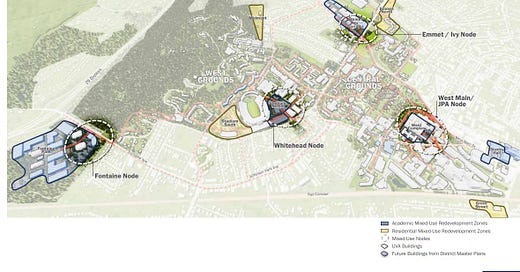





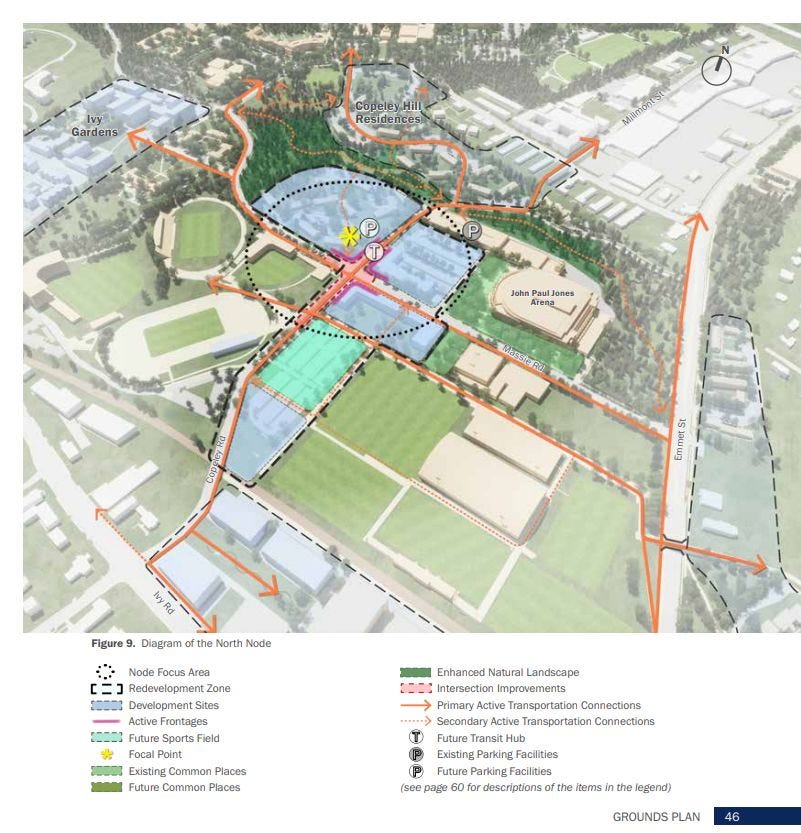
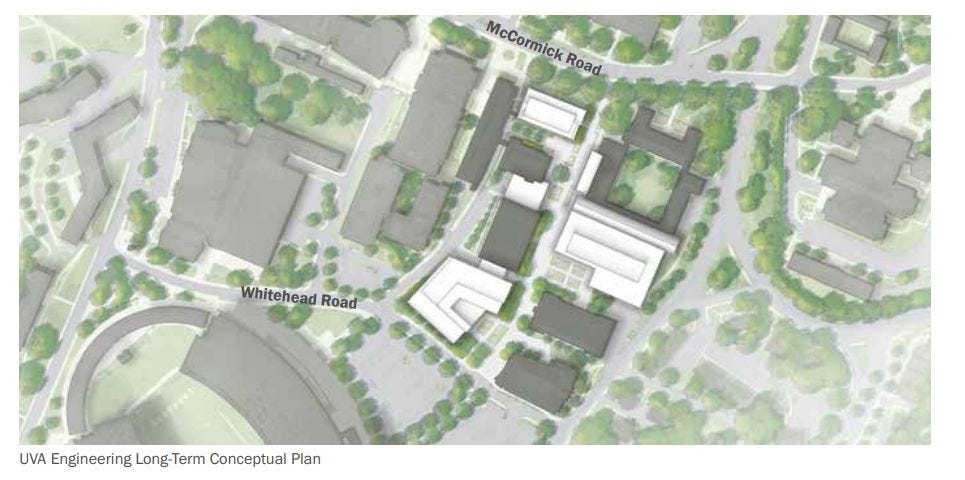










Share this post